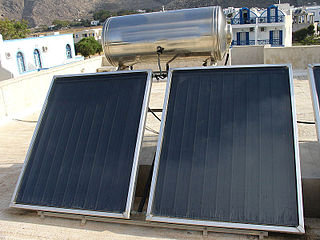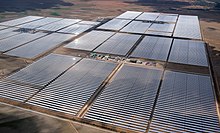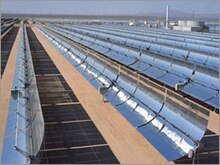
Solar energy is radiant light and heat from the Sun that is harnessed using a range of technologies such as solar power to generate electricity, solar thermal energy, and solar architecture. It is an essential source of renewable energy, and its technologies are broadly characterized as either passive solar or active solar depending on how they capture and distribute solar energy or convert it into solar power. Active solar techniques include the use of photovoltaic systems, concentrated solar power, and solar water heating to harness the energy. Passive solar techniques include orienting a building to the Sun, selecting materials with favorable thermal mass or light-dispersing properties, and designing spaces that naturally circulate air.

Solar thermal energy (STE) is a form of energy and a technology for harnessing solar energy to generate thermal energy for use in industry, and in the residential and commercial sectors.

A solar thermal collector collects heat by absorbing sunlight. The term "solar collector" commonly refers to a device for solar hot water heating, but may refer to large power generating installations such as solar parabolic troughs and solar towers or non water heating devices such as solar cooker, solar air heaters.

Solar Energy Generating Systems (SEGS) is a concentrated solar power plant in California, United States. With the combined capacity from three separate locations at 354 megawatt (MW), it was once the world's second largest solar thermal energy generating facility, until the commissioning of the even larger Ivanpah facility in 2014. It consisted of nine solar power plants in California's Mojave Desert, where insolation is among the best available in the United States.

Nevada Solar One is a concentrated solar power plant, with a nominal capacity of 64 MW and maximum steam turbine power output up to 72 MW net (75 MW gross), spread over an area of 400 acres (160 ha). The projected CO2 emissions avoided is equivalent to taking approximately 20,000 cars off the road. The project required an investment of $266 million USD, and the project officially went into operation in June 2007. Electricity production is estimated to be 134 GWh (gigawatt hours) per year.

There are several solar power plants in the Mojave Desert which supply power to the electricity grid. Insolation in the Mojave Desert is among the best available in the United States, and some significant population centers are located in the area. These plants can generally be built in a few years because solar plants are built almost entirely with modular, readily available materials. Solar Energy Generating Systems (SEGS) is the name given to nine solar power plants in the Mojave Desert which were built in the 1980s, the first commercial solar plant. These plants have a combined capacity of 354 megawatts (MW) which made them the largest solar power installation in the world, until Ivanpah Solar Power Facility was finished in 2014.

Concentrated solar power systems generate solar power by using mirrors or lenses to concentrate a large area of sunlight into a receiver. Electricity is generated when the concentrated light is converted to heat, which drives a heat engine connected to an electrical power generator or powers a thermochemical reaction.

Archimede combined cycle power plant is an integrated solar combined cycle (ISCC) power generation plant at Priolo Gargallo near Syracuse in Sicily, Italy. The combine cycle section was inaugurated in 2003, and the solar field on 14 July 2010. The solar field is the first to use molten salt for heat transfer and storage which is integrated with the combined-cycle gas facility. It uses technology developed by ENEA and Archimede Solar Energy, a joint venture between Angelantoni Industrie and Siemens Energy. Archimede is owned and operated by Enel.

A solar power tower, also known as 'central tower' power plant or 'heliostat' power plant, is a type of solar furnace using a tower to receive focused sunlight. It uses an array of flat, movable mirrors to focus the sun's rays upon a collector tower. Concentrating Solar Power (CSP) systems are seen as one viable solution for renewable, pollution-free energy.

Torresol Energy is a company dedicated to developing renewable energy and alternative energies, focusing on concentrated solar energy. It is based in the city of Getxo in Biscay Province (Vizcaya), in the Basque Country of northern Spain.
Martin Next Generation Solar Energy Center is the solar parabolic-trough component of an integrated solar combined cycle (ISCC) 1150 MW plant, in western Martin County, Florida, United States, just north of Indiantown. The project was built by Florida Power & Light Company (FPL). Lauren Engineers & Constructors (Abilene, TX) was the EPC contractor for the project. Its construction began in 2008 and was completed by the end of 2010.
A compact linear Fresnel reflector (CLFR) – also referred to as a concentrating linear Fresnel reflector – is a specific type of linear Fresnel reflector (LFR) technology. They are named for their similarity to a Fresnel lens, in which many small, thin lens fragments are combined to simulate a much thicker simple lens. These mirrors are capable of concentrating the sun's energy to approximately 30 times its normal intensity.

Shams Solar Power Station is a concentrating solar power station near Madinat Zayed, Abu Dhabi, the United Arab Emirates. The solar power station is located approximately 120 kilometres (75 mi) southwest of Abu Dhabi and 6 kilometres (4 mi) from Madinat Zayed on the road from Tarif to the Liwa Oasis.

The Valle Solar Power Station is a two adjacent twin 50 MW solar thermal power plants in San José del Valle, Cádiz, Spain, near the border with the Arcos de la Frontera (north) and the Jerez de la Frontera (west) municipalities, in the comarca of the Campiña de Jerez, a county with no administrative role.
Solar thermal enhanced oil recovery is a form of thermal enhanced oil recovery (EOR), a technique applied by oil producers to extract more oil from maturing oil fields. Solar EOR uses solar thermal arrays to concentrate the sun's energy to heat water and generate steam. The steam is injected into an oil reservoir to reduce the viscosity, or thin, heavy crude thus facilitating its flow to the surface. Thermal recovery processes, also known as steam injection, have traditionally burned natural gas to produce steam. Solar EOR is proving to be a viable alternative to gas-fired steam production for the oil industry. Solar EOR can generate the same quality steam as natural gas, reaching temperatures up to 750 °F (400 °C) and 2,500 PSI.
Solar energy – radiant light and heat from the sun. It has been harnessed by humans since ancient times using a range of ever-evolving technologies. Solar energy technologies include solar heating, solar photovoltaics, solar thermal electricity and solar architecture, which can make considerable contributions to solving some of the most urgent problems that the world now faces.

Renewable energy sources such as solar, wind, tidal, hydro, biomass, and geothermal have become significant sectors of the energy market. The rapid growth of these sources in the 21st century has been prompted by increasing costs of fossil fuels as well as their environmental impact issues that significantly lowered their use.
Termosolar Borges is a hybrid biomass-parabolic trough solar thermal power plant which provides electricity to Spain's transmission system. It is located about 100 kilometres (62 mi) west of Barcelona, about 10 kilometres (6.2 mi) south-east of Lleida, near Les Borges Blanques, Catalonia, Spain.
The Karoshoek Solar One Power Station, also Karoshoek Concentrated Solar Power Station, is a 100 megawatts concentrated solar power plant in South Africa. The solar component of this power station comprises curved mirrors that heat a fluid to a high temperature. The hot fluid is used to heat water, creating steam. The steam then "drives a steam turbine to convert the energy into electricity". That part of the power station is complemented by molten salt thermal storage technology, which "allows five hours of energy storage, enabling the plant to continue producing electricity in the absence of sunlight", supplying energy during South African peak hours. The consortium that owns the solar farm comprises foreign and domestic independent power producers (IPPs) and local and international financiers and other investors. A 20-year power purchase agreement (PPA), between the owners and Eskom, the South African electric utility company, governs the sale of the generated energy to Eskom, the off-taker. The power station achieved commercial commissioning in November 2018.


















